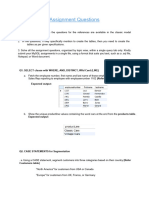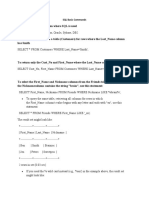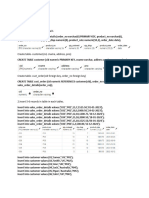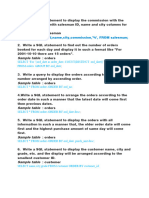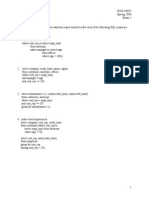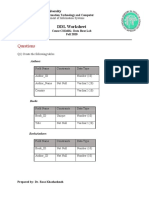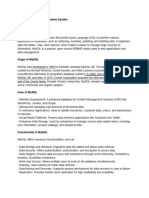Select Businessentityid, Firstname, Middlename, Lastname From Person - Person Where Middlename Like ' (E, B) '
Select Businessentityid, Firstname, Middlename, Lastname From Person - Person Where Middlename Like ' (E, B) '
Uploaded by
Debayan ChakrabortyCopyright:
Available Formats
Select Businessentityid, Firstname, Middlename, Lastname From Person - Person Where Middlename Like ' (E, B) '
Select Businessentityid, Firstname, Middlename, Lastname From Person - Person Where Middlename Like ' (E, B) '
Uploaded by
Debayan ChakrabortyOriginal Title
Copyright
Available Formats
Share this document
Did you find this document useful?
Is this content inappropriate?
Copyright:
Available Formats
Select Businessentityid, Firstname, Middlename, Lastname From Person - Person Where Middlename Like ' (E, B) '
Select Businessentityid, Firstname, Middlename, Lastname From Person - Person Where Middlename Like ' (E, B) '
Uploaded by
Debayan ChakrabortyCopyright:
Available Formats
Solve the following query using AdventureWorks2012 Database:
[Queries are based on following tables:
Person.Person, Sales.SalesOrderHeader, Person.Address,
Sales.SalesOrderDetail, Production.Product, Sales.Customer]
1) Write a query that displays the business entity ID number, first
name, middle name, and last name from the Person.Person table
for only those rows that have E or B stored in the middle name
column.
=========-------
SELECT BusinessEntityID, FirstName, MiddleName, LastName
FROM Person.Person
WHERE MiddleName LIKE '[E,B]';
2) Write a query displaying the order ID, order date, and total due
from the Sales.SalesOrderHeader table. Retrieve only those rows
where the order was placed during the month of September 2005
and the total due exceeded $1,000.
========--------
SELECT SalesOrderID, OrderDate, TotalDue
FROM Sales.SalesOrderHeader
WHERE OrderDate BETWEEN '2005-09-01' AND '2005-09-30'
AND TotalDue > 1000;
3) Explain the difference between the following two queries:
SELECT FirstName
FROM Person.Person
WHERE LastName LIKE 'Ja%es';
SELECT FirstName
FROM Person.Person
WHERE LastName LIKE 'Ja_es';
=======---------
'Ja%es' -> % sign can be replaced by any number of character. Like ‘James’, ‘jammes’,
‘Jamees’ etc.
'Ja_es' -> _ sign can be replaced by only 1 character. Only return ‘James’ but not return
‘jammes’ or ‘Jamees’.
3) Write a query that displays the first 10 characters of the
AddressLine1 column in the Person.Address table.
=======----------
SELECT LEFT(AddressLine1,10) AS Address10
FROM Person.Address;
4) Write a query displaying the first name and last name from the
Person.Person table all in uppercase.
========--------
SELECT UPPER(FirstName) AS FirstName, UPPER(LastName) AS LastName
FROM Person.Person;
5) Write a query that calculates the number of days between the
date an order was placed and the date that it was shipped using
the Sales.SalesOrderHeader table. Include the SalesOrderID,
OrderDate, and ShipDate columns.
=======----------
SELECT SalesOrderID, OrderDate, ShipDate,
DATEDIFF(d,OrderDate,ShipDate) AS NumberOfDays
FROM Sales.SalesOrderHeader;
6) Write a query that displays the count of orders placed by year for
each customer using the Sales.SalesOrderHeader table.
======-------------
SELECT CustomerID, COUNT(*) AS CountOfSales, YEAR(OrderDate) AS OrderYear
FROM Sales.SalesOrderHeader
GROUP BY CustomerID, YEAR(OrderDate);
7) Write a query that creates a sum of the LineTotal in the
Sales.SalesOrderDetail table grouped by the SalesOrderID. Include
only those rows where the sum exceeds 1,000
=====------
SELECT SUM(LineTotal) AS SumOfLineTotal, SalesOrderID
FROM Sales.SalesOrderDetail
GROUP BY SalesOrderID
HAVING SUM(LineTotal) > 1000;
You might also like
- Business Analysis Report: SQL Lite and Mysql ProjectDocument11 pagesBusiness Analysis Report: SQL Lite and Mysql ProjectSandya Vb76% (21)
- Microsoft SharePoint End User Training-SyllabusDocument3 pagesMicrosoft SharePoint End User Training-Syllabustaurus_vadivelNo ratings yet
- AmlDocument12 pagesAmlireshaNo ratings yet
- ArcGIS 10 Intro Exercise PDFDocument10 pagesArcGIS 10 Intro Exercise PDFDamai WongNo ratings yet
- Lwspafm4 001Document880 pagesLwspafm4 001Ricardo Quezada Rey100% (1)
- 70 461 SampleQuestionsDocument126 pages70 461 SampleQuestionsBZ SifdineNo ratings yet
- Join Practice QuriesDocument6 pagesJoin Practice Quries2kad28No ratings yet
- Dbms Draft3Document56 pagesDbms Draft3Pheo NixNo ratings yet
- 70 461Document76 pages70 461arjun.ec633No ratings yet
- sql imp coding quesDocument3 pagessql imp coding quesSonia SahuNo ratings yet
- ADB Week 5Document13 pagesADB Week 5salmantalibNo ratings yet
- 70-461 Dumps PDFDocument84 pages70-461 Dumps PDFJeff OgbNo ratings yet
- DbmsDocument4 pagesDbmsMariam shahzadiNo ratings yet
- SQL Assessment - Answer SheetDocument5 pagesSQL Assessment - Answer SheetabharnaNo ratings yet
- Seminar 3 - SQLDocument30 pagesSeminar 3 - SQLalixirwong99scribdNo ratings yet
- For The Submission of Your WorkDocument7 pagesFor The Submission of Your WorkLoc Tuan Hung (K16HL)No ratings yet
- Project FileDocument11 pagesProject FileShreya SinghNo ratings yet
- SQL AssignmentsDocument3 pagesSQL AssignmentsalivaNo ratings yet
- MYSQL Assignemnt QuestionsDocument8 pagesMYSQL Assignemnt QuestionsKnightdale RauschenbergNo ratings yet
- Company Database - Questions - UpdatedDocument7 pagesCompany Database - Questions - UpdatedmathuNo ratings yet
- Database Management Systems-Sql ModelDocument3 pagesDatabase Management Systems-Sql Modelguru262004No ratings yet
- LABORATOR 1 - BazeTeDhenashDocument6 pagesLABORATOR 1 - BazeTeDhenashNatasha SinaNo ratings yet
- SQL ProjectDocument15 pagesSQL ProjectArpita MishraNo ratings yet
- Workshop QuestionDocument7 pagesWorkshop QuestionKarthikJattiNo ratings yet
- Latest Microsoft EnsurePass 70 461 Dumps PDF 02 22Document87 pagesLatest Microsoft EnsurePass 70 461 Dumps PDF 02 22Madhavi PradeepNo ratings yet
- Final ExamDocument33 pagesFinal ExamLidia MartaNo ratings yet
- ADBMS Lab ManualsDocument14 pagesADBMS Lab ManualsJaswanth SudhaNo ratings yet
- Assignment 3Document9 pagesAssignment 3220103313No ratings yet
- Assignment 05: List The Customers Who Live On Main Street (In Any City)Document12 pagesAssignment 05: List The Customers Who Live On Main Street (In Any City)Sabir AliNo ratings yet
- Basic SQL Interview QuestionsDocument17 pagesBasic SQL Interview Questionsabbi abbiNo ratings yet
- 51CTO下载 70 461.95QDocument78 pages51CTO下载 70 461.95QzenglijunNo ratings yet
- Answer 2Document3 pagesAnswer 2hajer.ghinnewahNo ratings yet
- Microsoft - Practicetest.70 433.v2013!06!16.by - LionkingDocument138 pagesMicrosoft - Practicetest.70 433.v2013!06!16.by - LionkingbmashrequiNo ratings yet
- Microsoft Testbells 70-761 v2017-01-05 by Bob 70qDocument87 pagesMicrosoft Testbells 70-761 v2017-01-05 by Bob 70qArben KrivenjevaNo ratings yet
- Dbms Exp6 SolutionDocument4 pagesDbms Exp6 SolutionNishant PatilNo ratings yet
- create database Huma1Document3 pagescreate database Huma1Amanuel KassaNo ratings yet
- CH 12 Simple SQL Queries AssignmentsDocument6 pagesCH 12 Simple SQL Queries AssignmentsCharu SharmaNo ratings yet
- Oracle SQL Excercise 5 - Formatting OutputDocument2 pagesOracle SQL Excercise 5 - Formatting Outputaditya infaNo ratings yet
- SQL Assignment 4Document3 pagesSQL Assignment 4Ravikant Pandey100% (1)
- Nishtha AssignmentDocument11 pagesNishtha Assignmentangrejcanada78No ratings yet
- Quiz Niit MSSQLDocument15 pagesQuiz Niit MSSQLMcBride Muleya100% (1)
- Praktikum 2Document7 pagesPraktikum 2Jonatan SimbolonNo ratings yet
- Dbms Lab Problem SolutionDocument11 pagesDbms Lab Problem SolutionRikiNo ratings yet
- DWH DetailedprojectDocument17 pagesDWH Detailedprojectśáad 14053109No ratings yet
- 70 461 PDFDocument52 pages70 461 PDFMoe KaungkinNo ratings yet
- Access Database Case Study InstructionsDocument8 pagesAccess Database Case Study InstructionsAustin CombsNo ratings yet
- Final ProjectDocument3 pagesFinal Projectflexroo88No ratings yet
- Data Base Management Systems - Lab 2ND SEM BCA - Y2K8 SCHEMEDocument8 pagesData Base Management Systems - Lab 2ND SEM BCA - Y2K8 SCHEMEPoxitee PoxNo ratings yet
- 2 Mid TermDocument40 pages2 Mid TermfreeNo ratings yet
- AssignmentDocument3 pagesAssignmentDEE SAR DSNNo ratings yet
- 70 461Document41 pages70 461Prateek Srivastava100% (1)
- T-SQL Cheat SheetDocument20 pagesT-SQL Cheat SheetFrancesHsieh100% (1)
- AkshatDocument25 pagesAkshatKavyaNo ratings yet
- Exam 2Document7 pagesExam 2awilsmNo ratings yet
- SQL PracticalDocument43 pagesSQL Practical2023431371.chiragNo ratings yet
- Spring-2024 Database System Assignment # 3: Ofcomputer&Emergingsciencesfaisalabad-ChiniotcampusDocument3 pagesSpring-2024 Database System Assignment # 3: Ofcomputer&Emergingsciencesfaisalabad-ChiniotcampusF223124 Najeeb UllahNo ratings yet
- D22Document3 pagesD22Anil PradhanNo ratings yet
- Apache Cassandra Developer Associate - Exam Practice TestsFrom EverandApache Cassandra Developer Associate - Exam Practice TestsNo ratings yet
- Mastering SQL Queries for SAP Business One: Exploit one of the most powerful features of SAP Business One with this practical guide to mastering SQL Queries. With the skills to quickly acquire business intelligence, your enterprise can gain the competitive edge.From EverandMastering SQL Queries for SAP Business One: Exploit one of the most powerful features of SAP Business One with this practical guide to mastering SQL Queries. With the skills to quickly acquire business intelligence, your enterprise can gain the competitive edge.Rating: 4 out of 5 stars4/5 (1)
- Excel Programming: Your visual blueprint for creating interactive spreadsheetsFrom EverandExcel Programming: Your visual blueprint for creating interactive spreadsheetsRating: 3.5 out of 5 stars3.5/5 (3)
- Introductory Relational Database Design for Business, with Microsoft AccessFrom EverandIntroductory Relational Database Design for Business, with Microsoft AccessNo ratings yet
- SE PracticalDocument7 pagesSE Practicalpriyanshubawari11No ratings yet
- Shanna Hart Final PaperDocument5 pagesShanna Hart Final Paperapi-532717734No ratings yet
- PDB State ChangeDocument7 pagesPDB State ChangeprasemiloNo ratings yet
- SQL Server ReplicationDocument8 pagesSQL Server ReplicationNaveen MechuNo ratings yet
- Kartografska Zbirka Bosnjackog InstitutaDocument6 pagesKartografska Zbirka Bosnjackog InstitutaJohn SmithNo ratings yet
- Modeling Big Data With The Archimate 3.0 Language: Iver Band Open Group Conference, Austin, Texas July 19, 2016Document29 pagesModeling Big Data With The Archimate 3.0 Language: Iver Band Open Group Conference, Austin, Texas July 19, 2016GabrielGarciaOrjuelaNo ratings yet
- Questions: DDL WorksheetDocument3 pagesQuestions: DDL Worksheetkhaled al omariNo ratings yet
- PBB School Level Form 1.0 Region IV A Elementary FinalDocument4,317 pagesPBB School Level Form 1.0 Region IV A Elementary FinalEdlin RagasNo ratings yet
- Notes On Report Bursting in Cognos 83Document11 pagesNotes On Report Bursting in Cognos 83Gayathri NishtalaNo ratings yet
- Ugc Net Question BankDocument161 pagesUgc Net Question BankSujatha Menon100% (3)
- Oracle CDB vs. Non CDBDocument8 pagesOracle CDB vs. Non CDBtanvir.dblgroupNo ratings yet
- Eagle Point Mannual 2005 (Surface Modeling)Document13 pagesEagle Point Mannual 2005 (Surface Modeling)engineermik795680% (5)
- Storage Deployment Engineer Interview QuestionsDocument2 pagesStorage Deployment Engineer Interview QuestionsMidhun DasNo ratings yet
- Get All Employee Details From The Employee TableDocument23 pagesGet All Employee Details From The Employee TableSachin KumarNo ratings yet
- XP CmdshellDocument5 pagesXP Cmdshellwasim_ssNo ratings yet
- Fundamentals of Predictive Analytics A Business Analytics CourseDocument36 pagesFundamentals of Predictive Analytics A Business Analytics CourseKing ReyesNo ratings yet
- Glossary of Archival and Records TerminologyDocument463 pagesGlossary of Archival and Records TerminologyCarla FigariNo ratings yet
- Access Mode:: 7.13 Transaction Support in SQLDocument25 pagesAccess Mode:: 7.13 Transaction Support in SQL1AP18CS037 Shirish KulkarniNo ratings yet
- Rampant Advanced Oracle DBMS PackagesDocument591 pagesRampant Advanced Oracle DBMS Packagesdanko.bananknoNo ratings yet
- Modul 4 Bhs Inggris Kls 2 KD 3.4 - 4.4Document12 pagesModul 4 Bhs Inggris Kls 2 KD 3.4 - 4.4kebonarekNo ratings yet
- Delphix Use CasesDocument12 pagesDelphix Use CasesAlexandre MonteiroNo ratings yet
- En PSAAS Public Train BookDocument27 pagesEn PSAAS Public Train BookMariano MartinezNo ratings yet
- Railway Database PDFDocument21 pagesRailway Database PDFrashNo ratings yet
- A File Structure For The Complex, The Changing, and The IndeterminateDocument14 pagesA File Structure For The Complex, The Changing, and The IndeterminateRiccardo Mantelli100% (1)
- Database Management Systems (18Cs53) : Course OutcomeDocument20 pagesDatabase Management Systems (18Cs53) : Course Outcomestudy materialNo ratings yet
- Introduction PHR - HL7Document10 pagesIntroduction PHR - HL7Don JohnsonNo ratings yet
- MySQL (Summary)Document4 pagesMySQL (Summary)victorfem7No ratings yet


















